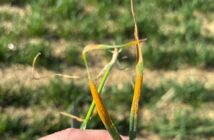Suspicions that the aggressive Warrior 3 rust race could be a threat this season have been raised by breeders Limagrain UK; growers are warned to be extra vigilant in checking their wheat crops.
The Warrior 3 race of yellow rust was identified at several sites across the UK by Limagrain breeders at the end of the 2015 growing season when yellow rust suddenly exploded on a number of varieties, despite their high resistance ratings, levels of infection very quickly reached significant levels.
Cereal pathologist with Limagrain, Paul Fenwick explains the findings: “We had some ‘very different and unusual yellow rust sightings’ last year in Scotland, Lincolnshire and Suffolk; varieties that were previously clean and resistant to known rust races were suddenly covered in rust. For example, Invicta had over 50% of its leaf area infected, despite its AHDB rating of 8.”
“From our geographically extensive trials, we have made our own isolates and tested them on seedlings and found all of them to be consistent with coming from the Warrior 3 group, as recently defined by the UK Cereal Pathogen Virulence Survey (UKCPVS).”
“This was not what we expected, as if we reference the findings presented at the UKCPVS stake-holders meeting in March, Warrior 3 pathotypes were found to be much less frequent than Warrior 4-6 type in 2015.”
“However, if our findings are correct, and Warrior 3 has increased its frequency in the mix of yellow rust types out there now, it’s possible that we could be seeing some real surprises in varietal resistances in 2016, and most probably before the latter part of the season”, he says.
It is believed that all the Warrior group of races originated in the Himalayan region, and the fact these are from a sexual population goes some way to explaining their variability and atypical characteristics compared to the clonal, European population that we’ve been used to for so long. The Warrior groups of yellow rust are now totally dominant within the UK population and also across Europe.
“Limagrain is routinely running seedling tests – as it is important for us to characterise both seedling and adult plant resistance to the various strains of yellow rust. We’ve recently found that seedlings are generally more susceptible to new races compared to isolates from the old population – some of the new ones appears to be particularly aggressive in our seedling tests, and could be one explanation for why we are seeing such high levels of yellow rust in fields currently,” adds Mr Fenwick.
“We know that the Kranich race has been detected for the first time in the UK (a single occurrence in 2014), but much like the Warrior 3 race, the actual risk posed by it is still unknown at this stage. It might be that we need to be equally concerned about this race, as the Warrior 3 races.”
“As breeders, we are constantly working, with the help of genetic markers, to gain a better understanding of the genetics underlying the rust resistance in our varieties. Whilst many important resistance genes have become less effective against the Warrior races, we are also seeing that some, previously overcome genes, are now working again.”
“The reality is that we don’t know where it will be seen again or how the Warrior 3 race will behave, but we do know that it appears to be more aggressive than the Warrior 4 race, so the message for growers is that they need to be extremely vigilant in checking their crops and don’t take any varietal resistance ratings for granted,” adds Ron Granger, technical manager with Limagrain.
Manufacturers BASF say that if yellow rust symptoms appear in crops, growers should take a zero tolerance approach. “There is a lot of uncertainty about which varieties are likely to develop rust and we are seeing active disease in a range of varieties which would not normally be considered high risk,” says agronomy manager Louis Wells.
“There is still a versatile and effective toolbox available so growers should feel confident about control; epoxiconazole is the best rust triazole, pyraclostrobin the best strob. Where using an SDHI ensure you choose an SDHI which is partnered with epoxiconazole – in practice this means Adexar.”
“Chlorothalonil (CTL) should also be included to boost Septoria control and as an anti-resistance strategy. In our trials, the potential for antagonism from adding CTL can be even greater when treating rust than septoria, but we have never seen an issue of this with Adexar,” he says.



